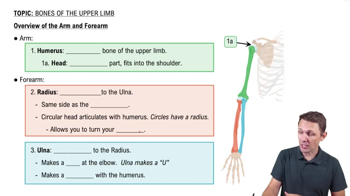Mr. Bell presents with the inability to move certain muscles on one side of his face. You ask him to make various facial expressions and find that on his right side he is unable to purse his lips, pull in his cheeks, elevate his upper lip, and smirk. What muscles is Mr. Bell unable to contract?
Predict the location and function of the flexor digitorum profundus muscle based only on its name.
 Verified step by step guidance
Verified step by step guidance
Verified video answer for a similar problem:
Key Concepts
Muscle Anatomy

Muscle Function

Forearm Musculature

Which of the following muscle groups is considered muscles of inspiration?
a. External intercostal muscles
b. Internal intercostal muscles
c. External oblique muscles
d. Internal oblique muscles
Mr. Bell presents with the inability to move certain muscles on one side of his face. You ask him to make various facial expressions and find that on his right side he is unable to purse his lips, pull in his cheeks, elevate his upper lip, and smirk. What muscles is Mr. Bell unable to contract?
Match the muscle with its main action:
_____Sternocleidomastoid muscle
_____Transversus abdominis muscle
_____Internal oblique muscle
_____Rectus abdominis muscle
_____Splenius capitis muscle
_____Quadratus lumborum musclea.
a. Laterally flexes the trunk
b. Flexes the trunk
c. Compresses the abdominal cavity
d. Extends the vertebral column
e. Flexes the head
f. Extends the head
Which of the following is not a muscle of the rotator cuff?
a. Teres major muscle
b. Teres minor muscle
c. Subscapularis muscle
d. Infraspinatus muscle
e. Supraspinatus muscle
